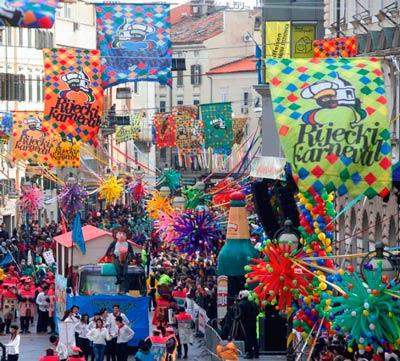The world's most famous carnival celebrations are held in Rio de Janeiro, Québec, Venice and Cologne.
Carnival originated centuries ago and has remained a symbol of the Catholic mentality. It begins each year on 6th January (Epiphany) and ends on the night before Ash Wednesday, on which a Fašnik - which symbolically represents all of the vices of the year past - is burned.
The world's most famous carnivals take place in Rio de Janeiro, Québec, Venice and Cologne, but there is also a long tradition of celebrating carnival in Croatia, where the celebrations are a real highlight. The most famous carnivals in Croatia take place in the Kvarner Bay – in Rijeka, Opatija and Kastav.
Carnival in Rijeka
 The carnival in the port city of Rijeka is the largest and most famous Croatian carnival and has a long tradition. Festivities begin each year with the coronation of the freshly crowned prince and princess and the handing over of the keys to the town hall and end with a children's parade. The main highlight is the international carnival parade through the town with participants and spectators from around the world.
The carnival in the port city of Rijeka is the largest and most famous Croatian carnival and has a long tradition. Festivities begin each year with the coronation of the freshly crowned prince and princess and the handing over of the keys to the town hall and end with a children's parade. The main highlight is the international carnival parade through the town with participants and spectators from around the world.
The Opatija Riviera organises a parade of decorated floats. The Balinjerada sees masked participants driving their floats down the steep streets of Opatija, often risking life and limb.
Other well-known carnival customs in the Kvarner area include the procession of Zvončari (bell ringers) of Kastav near Rijeka. Dressed in sheepskins and hidden behind animal masks, they roam the streets to welcome the spring and exorcise evil spirits. The Zvončari wear white trousers, blue and white t-shirts, a sheep skin, a red bandana and bells. Since 2009, this tradition has been included on UNESCO list of Intangible Cultural Heritage.
Carnival season in Split and Dubrovnik

Large carnival parades are also organised in several other towns and cities on the Adriatic Coast.
The carnival in Split differs from those in other Croatian cities, because most masked balls traditionally took place in palaces and libraries.
The carnival in Dubrovnik dates back to the 14th century. Since at that time masks were banned, people wore national costume instead. At the beginning of the 20th century social differences were very visible: while the aristocrats held their masked balls in palaces, the commoners celebrated on the streets below.
However, celebrations aren't limited to the Adriatic coast and the Bay of Kvarner. The town of Samobor (20km from the Croatian capital Zagreb) in the interior of Croatia, has also been known as a vibrant carnival destination for several centuries.
 No exams, please!
No exams, please!
Although Shrove Tuesday isn't a national holiday in Croatia, in many Croatian schools students who dress up and wear costumes to school on this day are exempt from oral examinations!
Many of the foods traditionally enjoyed during carnival are made of the ingredients forbidden during lent, such as fat, eggs and meat.
Particularly popular savoury foods are pork and bacon and the most popular sweet food is the traditional, decorated doughnut.
We wish you an unforgettable carnival season, perhaps in a carnival parade in Croatia!
Exercise: Can you guess what the following words and phrases mean?
fašnik, karneval, maškare, poklade
Answer
Carnival, Mardi Grad
karnevalska parada
Answer
Carnival parade
karnevalska povorka
Answer
Carnival parade
karnevalski bal
Answer
Carnival ball
karnevalski običaj
Answer
Carnival tradition
korizma, vrijeme posta
Answer
Lent
maska
maskenbal
Answer
Masked
Pepelnica
Answer
Ash Wednesday
pokladni kostim
Answer
Carnival costume
pokladni utorak
Answer
Shrove Tuesday
pokladnica, krafna
Answer
Doughnut


 The carnival in the port city of Rijeka is the largest and most famous Croatian carnival and has a long tradition. Festivities begin each year with the coronation of the freshly crowned prince and princess and the handing over of the keys to the town hall and end with a children's parade. The main highlight is the international carnival parade through the town with participants and spectators from around the world.
The carnival in the port city of Rijeka is the largest and most famous Croatian carnival and has a long tradition. Festivities begin each year with the coronation of the freshly crowned prince and princess and the handing over of the keys to the town hall and end with a children's parade. The main highlight is the international carnival parade through the town with participants and spectators from around the world.




